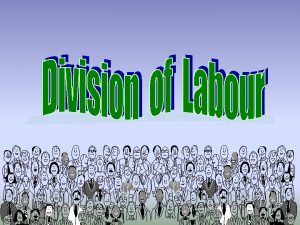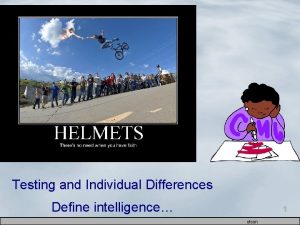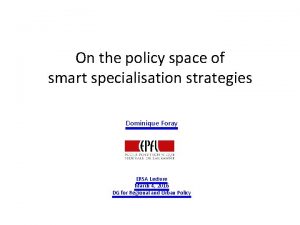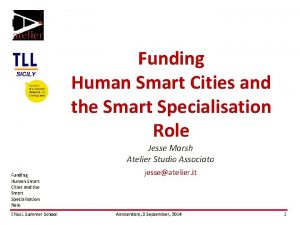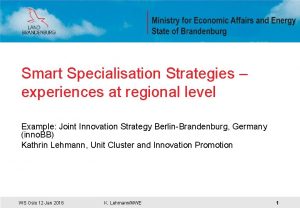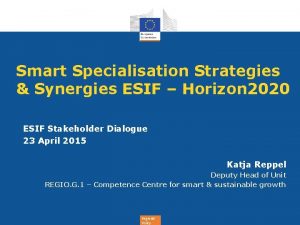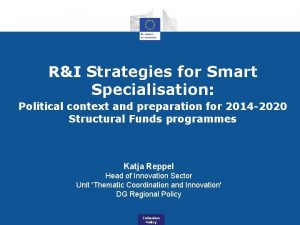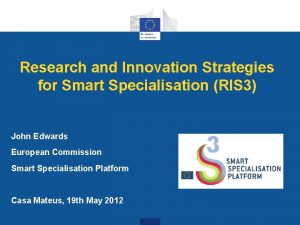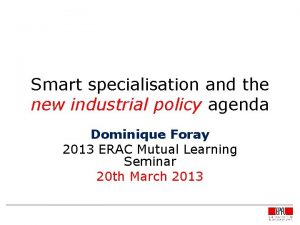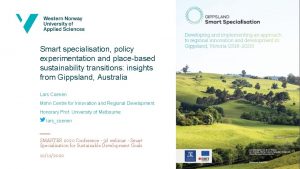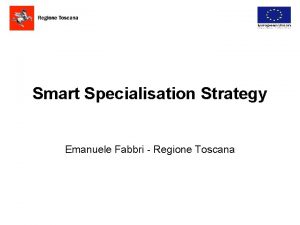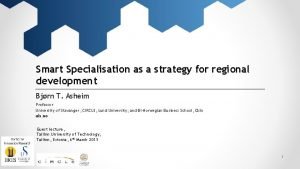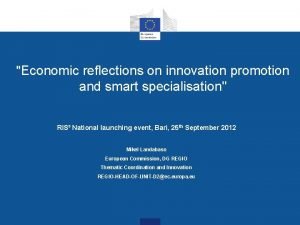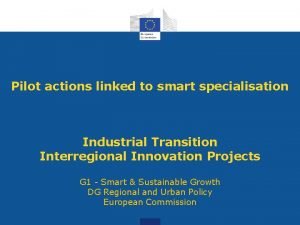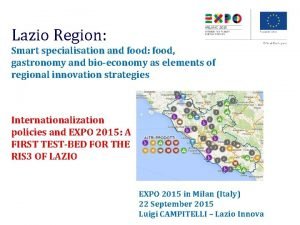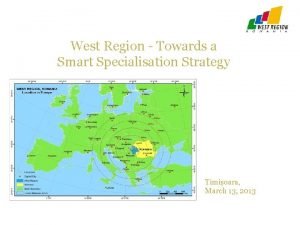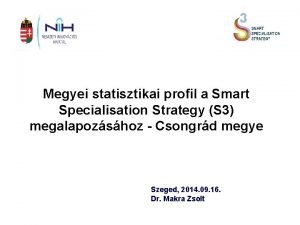On the policy space of smart specialisation strategies





























- Slides: 29

On the policy space of smart specialisation strategies Dominique Foray ERSA Lecture March 4, 2016 DG for Regional and Urban Policy

• In search for effective policies to drive positive structural changes (diversification, modernisation, new industries) in European regional economies

Policy to drive structural changes Horizontal policy The innovation policy space - 1

Policy to drive structural changes Horizontal policy Likely to drive structural changes through mechanisms such as: Mobility Spin-off, start up Diversification of firms Networking (Boschma and Frenken, 2011) The innovation policy space - 1

Horizontal Policy is not enough • These policies failed in many cases (less developed/transition regions) – Horizontal policy did not reduce the knowledge gap – When the knowledge gap has been some what reduced, this did not translate into real economic progress • Innovation requires not only that « the basics are right » but also specific capabilities and resources – In top regions these are provided by the main actors of innovation – In less advanced regions, « firms are home alone » (S. Berger) • Local ecosystems and capabilities as the « third boundary conditions » • Need for a policy to support the emergence of ‘complete’ systems of innovations in particular activities where future competitive advantages can be built

Biotech & ICT in fischeries and canning industry Internet application and ecommerce for tourism services Advanced manufacturing technologies in the footwear industry Animal genetics for breeding Microsystems of innovations emerge from connections between entrepreneurs, suppliers, research, lead users, etc. . to open and explore a new domain of opportunities The new activities are complementing existing structures with the aim to transform them The economic value of building local capabilities does not mean it is a closed process for an autarkic region

• But this is another logic of policy which is sector non neutral or sector specific… • . . and it is necessary: – « The idea that the government can disengage from specific policies and just focus on general framework conditions in a sector neutral way is an illusion based on the disregard for the specificity and complexity of the requisite publicly provided inputs and capabilities » Hausmann and Rodrik, 2006

Policy to drive structural changes Horizontal policy Sector nonneutral policy The innovation policy space - 2

• Supporting the emergence of micro-systems of innovation in various sectors is an expensive policy • Different activities require different things • This is haute couture rather than ready to wear • The local government cannot address all potential capabilities needs for all new activities • « We are doomed to choose » (Hausmann and Rodrik, 2006) • RIS 3 : choice of (specialisation in) activities aiming at transforming sectors (or establishing new ones) • How to solve the choice problem?

Policy to drive structural changes Horizontal policy Sector nonneutral policy Top down Central planning mode The innovation policy space - 3

• The usual (old fashioned) response: government as the omniscient planner. • The principal knows ex ante what to do and set the incentives for the firms to execute the plan

Policy to drive structural changes Horizontal policy Sector nonneutral policy Cluster policy based on Government dictating what technology in what region The innovation policy space - 3 Top down Central planning mode

• Issues of distorsions, picking winners, government failures, policy capture and anti-competitive effects • “Although it is certainly true that not everything can be done at once, focus on selected areas for large investments to the neglect of the rest of the economy is a highly questionable strategy. Why it would be preferable to allocate scarce capital so that some activities have excellent infrastructures while others must manage with seriously deficient structure is not clear: without further evidence, it would appear to be a distortion”. (A. Krueger) • Krueger is right. . but this does not mean we should give up any sectoral non-neutral policies

Policy to drive structural changes Horizontal policy Sector nonneutral policy “What if, as I and many others assume, there are no principals…with the robust and panoramic knowledge needed for this directive role ? ” (Sabel) The innovation policy space - 4 Top down Central planning mode

Policy to drive structural changes Horizontal policy Sector nonneutral policy RIS 3 (new industrial policy) The innovation policy space - 4 Top down Central planning mode

Policy to drive structural changes Horizontal policy Sector nonneutral policy RIS 3 (new industrial policy) Top down Central planning mode Development policy – Hausmann and Rodrik Mission-oriented policy – Foray, Mowery and Nelson High tech policy – Aghion and Akcigit Trajtenberg Self-organizing industry investment boards – Romer Smart specialisation – Foray, David and Hall

Policy design issues • Choices are inevitable to undertake strategic actions; mistakes need to be minimized • Mistake type 1 : the Government has the perfect knowledge and knows ex ante what should be done. – In RIS 3, specialisations are not given ex ante • Mistake type 2 – choices are made at sectoral level • Mistake type 3 – choices are made for ever (as in the world of Ricardo)

Design principle 1 Entrepreneurial discovery • The government does not have innate wisdom or the ex-ante knowledge about future priorities. • The knowledge about what to try and where to go is not obvious and not visible! It is hidden – It needs to be discovered! – From Hayek to Sabel – The discovery process forms an integral part of political action • E means entrepreneurial (in a broad sense) : firms, universities, public research, lead users, communities • D means discovery, i. e. opening and exploring a new domain of opportunities –mainly through the integration and recombination of different types of knowledge

Entrepreneurial discovery cont. • ED precedes innovation – Not an extraordinary event – In many cases ED is internalized in large companies – In many other cases it requires networks and collaboration • ED has a strong informational dimension – its social value • ED matters twice – As a generic step of many processes of positive structural changes - to open and explore a new domain of opportunities for diversification, modernisation, etc. . – As a solution to the information problem that the Government faces when comes the time of choices • Based on this information, the Government can select a few number of new activities according to criteria about potential impact, feasibility , proximity to market, significance for the regional economy, number of actors involved, etc.

Design principle 2 No sectoral prioritisation • What is prioritized is not a sector but the new activity aiming at transforming the sector or establishing a new one (meaning that the strategy only involves the segment of the sector which is part of the new activity) • Sectoral prioritization creates distorsions • Activity level is the right one to see in detail the pieces of the knowledge economy that a region or country can take as a basis for its smart specialisation strategy

Design principle 3 RIS 3 has an experimental nature • A few bets are placed on various domains • RIS 3 is a living document – After 5/6 years a new activity is no longer new (as a success or a failure it needs to exit) – New discoveries happen all the time and a few very new activities need to be integrated in the strategy

Pre-identfication of potential areas Pre-identification of « opportunities areas» Pre-identification of « sector areas» No pre-identification Level of granularity between sectors and microprojects. It matters for ED Programs to maximize e. d. e. g. call for proposals, platforms ed Priorities RIS 3 portfolio of activities at t Ex ante assessment Selection ed 1 ed 2 ed ed ed 3 Supporting microsystems of innovation

Pre-identfication of potential areas or not Micro-systems Local and sustainable production of the agrofood sector Programs to maximize e. d. e. g. call for proposals, platforms Smart -inn Priorities RIS 3 portfolio of activities at t Ex ante assessment Selection 3 S Mems 1 2 Micro D 2 Micro-technics for the luxury industry 3 innov therapy Smart mobility Région Franche. Comté Supporting microsystems of innovation

Pre-identfication of potential areas or not Pre-identification of « opportunity areas» Pre-identification of « sector areas» No pre-identification RIS 3 is a living document Programs to maximize e. d. e. g. call for proposals, platforms ed Priorities RIS 3 portfolio of activities at t+5 Ex ante assessment Selection ed 1 ed 2 ed 4 ed 5 ed 3 ed Supporting microsystems of innovation

A smart specialisation strategy involves. . • . . putting in place a process: • to identify sectors and emerging domains where structural changes are desirable • to stimulate (and learn from) entrepreneurial discovery processes (edp) • to concentrate resources on a few number of activities (emerging from the edp) • to help these activities to grow (specific capabilities and complementary resources) • to measure progress • to re-initiate the process at any time

Policy to drive structural changes Horizontal policy Sector nonneutral policy RIS 3 (new industrial policy) Beyond Principal-Agent gouvernance Centrality of entrepreneurial discovery Top down Central planning mode

Lessons from the EU experiment? • Great impact : “Smart specialization (SS) program of European Commission is currently the biggest experiment in innovation and industrial policy in the world and possibly biggest ever undertaken” (Kutzesnov and Sabel). . • …but ex ante conditionality as a key factor • Price to pay (implementation) – – No time for pilot study One size fits all « Specialisation » : is there a better word? The language of ED and RIS 3 becomes common place in Europe but what we see being implemented in practice is often the rethoric not the substance

• Risks of incrementalism? Regions being locked in (trapped in) trajectories of minor innovation • This is not a risk – just the philosophy of RIS 3: – In innovation there is not just one game in town – there are different orders of innovation • For many regions, the key point is not inventing at the frontier but rather generating innovational complementarities in adopting sectors – These types of complementarity actions (adoption of ICT or biotech, local innovations in trad. sectors, . . ) may be less flashy, less overtly innovative, and yet these ultimately constitute the key to economy-wide growth • Based on a good RIS 3, a ‘secondary region’ can at least become a good follower – Capable of allocating R&D and other innovative inputs so as to lever the growth potential of the prevalent KET (GPT) invented elsewhere

Thank you
 Specialisation of labour definition
Specialisation of labour definition Courts hierarchy
Courts hierarchy Street smarts vs book smarts
Street smarts vs book smarts One smart man he felt smart
One smart man he felt smart It's not how smart you are it's how you are smart meaning
It's not how smart you are it's how you are smart meaning Everfi answers smart shopping
Everfi answers smart shopping Eight types of intelligence
Eight types of intelligence Kim ung yong
Kim ung yong Street smart vs book smart quotes
Street smart vs book smart quotes One smart man he felt smart
One smart man he felt smart Joint space vs cartesian space
Joint space vs cartesian space Space junk the space age began
Space junk the space age began Camera space to world space
Camera space to world space Cartesian space vs joint space
Cartesian space vs joint space World space computer
World space computer Hình ảnh bộ gõ cơ thể búng tay
Hình ảnh bộ gõ cơ thể búng tay Slidetodoc
Slidetodoc Bổ thể
Bổ thể Tỉ lệ cơ thể trẻ em
Tỉ lệ cơ thể trẻ em Voi kéo gỗ như thế nào
Voi kéo gỗ như thế nào Tư thế worms-breton
Tư thế worms-breton Chúa sống lại
Chúa sống lại Các môn thể thao bắt đầu bằng từ đua
Các môn thể thao bắt đầu bằng từ đua Thế nào là hệ số cao nhất
Thế nào là hệ số cao nhất Các châu lục và đại dương trên thế giới
Các châu lục và đại dương trên thế giới Công của trọng lực
Công của trọng lực Trời xanh đây là của chúng ta thể thơ
Trời xanh đây là của chúng ta thể thơ Mật thư tọa độ 5x5
Mật thư tọa độ 5x5 101012 bằng
101012 bằng Phản ứng thế ankan
Phản ứng thế ankan
